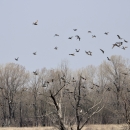Visit Us
Quivira National Wildlife Refuge was established in 1955 to provide and protect vital habitat for migratory waterfowl in the Central Flyway, conserving a unique combination of rare inland salt marsh salt marsh
Salt marshes are found in tidal areas near the coast, where freshwater mixes with saltwater.
Learn more about salt marsh and sand prairie. Quivira is a veritable oasis within this region, offering feeding, resting, and nesting areas for a wide variety of waterfowl, shorebirds, and other wetland bird species. Over 340 species of birds have been documented at Quivira, this diversity is typically found only in coastal areas or along large river systems. Quivira has been listed as critical habitat for both the endangered whooping crane and rare interior least terns as well as the threatened western snowy plover. These rare birds make Quivira a destination for bird-watchers especially during migration when flocks of geese and sandhill cranes come through as well as the whooping cranes. The Auto-Tour road around Big Salt Marsh provides an excellent opportunity for bird-watching and photography.
Activities
Quivira can be explored in a variety of ways. The Refuge is open daily from 1-1/2 hours before sunrise to 1-1/2 hours after sunset. Drive the roads, hike the landscape, or just watch nature. Start your visit at the Visitor Center, located in the south end of the Refuge to learn about visitor opportunities.
Trails
Walking trails are maintained in two main areas of Quivira: the Headquarters area and Migrant's Mile. All of the Refuge is open to foot travel (with the exception of a few areas closed seasonally due to nesting birds). Be sure to park in the over 30 designated parking areas located around Quivira, don't block any gates. Don't leave valuables in your vehicle. Be aware, during wet periods, access to many areas may be limited due to the abundance of scattered wetlands. Use caution in areas of uneven terrain. There is one species of poisonous snake found on the Refuge, the Massassauga rattlesnake.
Other Facilities in the Complex
Quivira is one of three Refuges that are part of the Kansas Refuges Complex. The other two are Marais des Cygnes National Wildlife Refuge and Flint Hills National Wildlife Refuge. The Great Plains Nature Center in Wichita which is run as a partnership with the City of Wichita and the State of Kansas is also part of the Complex.
Great Plains Nature Center
The Great Plains Nature Center is a cooperative project between the U.S. Fish & Wildlife Service, Kansas Wildlife & Parks, City of Wichita, and the Friends of the Great Plains Nature Center. These Partners share a common goal of providing opportunities for the public to investigate, understand and develop an appreciation for wildlife and the environment, while promoting sound stewardship of natural resources.
Rules and Policies
The following regulations are necessary for the protection of wildlife and wildlife habitat, and for the safety of visitors. Observance of these rules will help make the Refuge a better place for visitors and the wildlife they come to enjoy. The Refuge manager reserves the right to close all or part of the Refuge to hunting and/or public access at any time. Specific regulations will be posted. The Refuge is also subject to Federal, State, and local laws and regulations.

